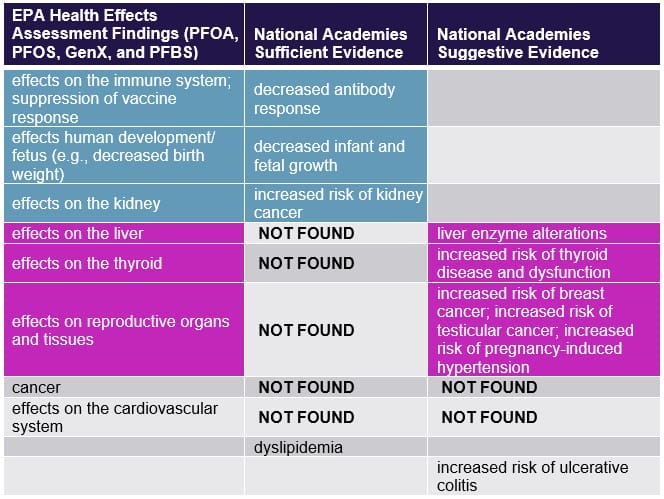Per- and polyfluoroalkyl substances (PFAS), also called “forever chemicals,” are a group of manufactured compounds whose presence in residential soil, industrial soil, and tap water has drawn heightened attention from legislators, regulatory authorities, and businesses alike.
EPA recently updated its interim lifetime health advisories for PFOA and PFOS and its final health advisories for GenX and PFBS. Lifetime health advisories, or LHAs, are non-enforceable drinking water advisories set for contaminants that may cause negative human health effects and are known or anticipated to occur in drinking water.
These values provide technical guidance to states, agencies, and other public health officials in evaluating drinking water quality. Both EPA and the National Academies of Sciences, Engineering, and Medicine (National Academies), a nonprofit society of scholars established to provide independent and objective advice on matters related to science and technology, evaluated the health impacts of PFAS, PFOA, GenX, and PFBS, but there were several notable differences in their findings that are relevant to the regulated community and industries that might be the target of PFAS litigation.
Lifetime Health Advisories Studies and Findings
EPA found potential health effects for PFOA, PFOS, GenX, and PFBS, but the studies EPA relied on to establish the LHAs for PFOA and PFOS are based on human epidemiological studies, while EPA relied on animal studies to establish the final LHAs for GenX and PFBS.
PFOA and PFOS
The interim updated health advisories for PFOA and PFOS are based on human epidemiology studies in exposed populations. The new health advisories set by EPA for PFOA and PFOS are massively lower than those previously issued by EPA in 2016.

EPA reviewed studies of health effects in humans and found associations between PFOA and/or PFOS exposure and effects on the human immune system, the cardiovascular system, human development, and cancer. The most sensitive non-cancer effect for PFOA and PFOS that EPA relied on is suppression of vaccine response (decreased serum antibody concentrations) in children. While the suppression of vaccine response is a potentially serious effect of PFOA and/or PFOS exposure, the extremely low prevalence of the childhood diseases analyzed in the study is important. For example, one of the key endpoints evaluated for PFAS exposure is reduced antibody serum for Diptheria and Tetanus in children, but the incidence of Diptheria and Tetanus is extremely low in the United States.
GenX and PFBS
For the final health advisories for GenX chemicals and PFBS, EPA relied on animal toxicity studies following oral exposure to these chemicals. GenX chemicals have been linked to health effects on the liver, the kidney, the immune system, and developmental effects, as well as cancer.

National Academies Review
The Agency for Toxic Substances and Disease Registry (ATSDR) and the National Institute of Environmental Health Sciences (NIEHS) asked the National Academies to form a committee to advise on PFAS testing and clinical care for patients exposed to PFAS. The evaluation included a review of the human health literature on health effects of PFAS compounds including PFOA, PFOS, GenX, and PFBS.
The committee summarized the available evidence into four categories of association:
- Sufficient evidence of an association,
- Limited suggested evidence of an association,
- Inadequate or insufficient evidence of an association, and
- Limited suggestive evidence of no association.[1]
Comparison of EPA and the National Academies Findings

There are several adverse health outcomes on which EPA’s LHAs are based that were not supported by the National Academies, including cancer and effects on the cardiovascular system. The report’s finding of a “limited” or weak association between PFAS exposure and certain types of cancer — such as breast cancer, and testicular cancer — is particularly notable given the inherently conservative presumptions underlying EPA’s lifetime drinking water health advisories.
Further, EPA also found health effects on the liver, the thyroid, and reproductive organs and tissues, while the National Academies found only suggestive evidence of these impacts from PFAS exposure. This finding from the National Academies further undermines the ultra-conservative LHA’s adopted by EPA. It is worth noting that the National Academies found sufficient evidence of dyslipidemia (abnormally elevated cholesterol) and suggestive evidence of increased risk of ulcerative colitis not found by EPA. However, any causative impacts based on the Report, would be limited to those specific health effects.
The National Academies’ report calls into question any finding of causation based on EPA’s LHAs for the four PFAS compounds. While the National Academies’ report found some suggestive evidence of certain associations, the Report stopped short of stating that there was any “causal effect,” in contrast to an “association.”
The absence of a causation finding is significant for toxic tort cases, which require plaintiffs to plead and prove causation. Critically, the National Academies’ report found no evidence of a causal link between PFAS and any adverse health outcome. Stated differently, there was not sufficient evidence to affirmatively identify PFAS as the cause of an adverse health effect. This is a critical conclusion for entities that may defend against claims of health outcomes allegedly caused by PFAS exposure.
[1] National Academies Report at 7.